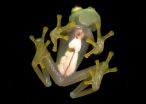(Press-News.org) Researchers at UCL have studied the behaviour of the Sun's coronal mass ejections, explaining for the first time the details of how these huge eruptions behave as they fall back onto the Sun's surface. In the process, they have discovered that coronal mass ejections have a surprising twin in the depths of space: the tendrils of gas in the Crab Nebula, which lie 6500 light-years away and are millions of times larger.
On 7 June 2011, the biggest ejection of material ever observed erupted from the surface of the Sun. Over the days that followed, the plasma belched out by the Sun made its way out into space. But most of the material propelled up from the Sun's surface quickly fell back towards our star's surface.
For the solar physicists at UCL's Mullard Space Science Laboratory, watching these solar fireworks was a unique opportunity to study how solar plasma behaves.
"We've known for a long time that the Sun has a magnetic field, like the Earth does. But in places it's far too weak for us to measure, unless we have something falling through it. The blobs of plasma that rained down from this beautiful explosion were the gift we'd been waiting for", says David Williams, one of the study's authors.
Since 2010, the NASA Solar Dynamics Observatory (SDO) has been constantly photographing the surface of the Sun. To our eyes, our star seems almost unchanging, with occasional fleeting sunspots the only changes that can be seen without special apparatus. But the SDO's instruments can cut through the dazzling brightness, magnify the detail and see wavelengths of light which are blocked by the Earth's atmosphere. This combination of high-quality imaging and constant monitoring means that scientists can now see the detail of how the Sun's dynamic surface changes over time.
The 7 June 2011 eruption was by some margin the biggest recorded since this constant monitoring began, meaning the huge cascade of matter that fell back into the Sun following the eruption was a unique opportunity to study, on an unusually large scale, the fluid dynamics of these phenomena.
"We noticed that the shape of the plume of plasma was quite particular," says Jack Carlyle, lead author of the study. "As it fell into the Sun, it repeatedly split apart like drops of ink falling through water, with fingers of material branching out. It didn't stick together. It's a great example of an effect where light and heavy fluids mix."
Less dense materials typically float on top of denser ones without mixing together, for example oil sitting on water, or layers of different liqueurs in a cocktail. Change the order by putting the denser fluid on top, however, and the denser one will quickly fall through the less-dense one until their positions are reversed. The complex pattern formed by the denser fluid as it repeatedly splits and branches into ever-finer 'fingers' of matter, is caused by a phenomenon known as the Rayleigh-Taylor instability.
The team noticed in SDO's high-resolution images that the falling plasma clearly underwent the Rayleigh-Taylor instability as it returned to the Sun's surface. This is as would be expected – the solar plasma is denser than the solar atmosphere it is falling through. In space, a similar effect has been observed before, albeit on a much larger scale, in the Crab Nebula.
The Crab Nebula is the remnant of a supernova which exploded in the 10th century. In the millennium that has followed the explosion, denser matter has started to fall back into the centre of the nebula, exhibiting the same finger-like structures as the team observed in the Sun.
A major study of the Crab Nebula in 1996 found that the Rayleigh-Taylor instability in the Crab Nebula was actually slightly modified. The highly magnetised environment in the nebula changes the proportions of the fingers, making them fatter than they would be otherwise.
The UCL team found that the same effect was going on in the 7 June 2011 coronal mass ejection: even in an area where the Sun's magnetic field was weak, it was modifying the Rayleigh-Taylor effect, changing the shape of the plume of plasma as it fell back into the Sun. This is the most spectacular example of the effect ever observed on the Sun.
INFORMATION:
Full story including photos and video: http://www.ucl.ac.uk/maps-faculty/maps-news-publication/maps1407
The study is published in the 20 February issue of the Astrophysical Journal.
Notes
The research appears in a paper entitled "Investigating the dynamics and density evolution of returning plasma blobs from the 2011 June 7 eruption", published in the 20 February 2014 issue of the Astrophysical Journal: http://iopscience.iop.org/0004-637X/782/2/87/article
Contact (science)
Dave Williams
UCL MSSL
d.r.williams@ucl.ac.uk
+44 (0)1483 204 202
Contact (media)
Oli Usher
UCL Faculty of Mathematical & Physical Sciences
o.usher@ucl.ac.uk
+44 (0)20 7679 7964
Astronomers find solar storms behave like supernovae
2014-02-20
ELSE PRESS RELEASES FROM THIS DATE:
High potency statins linked to better outcome following a heart attack
2014-02-20
A study looking at the data of thousands of patients who suffered heart attacks has suggested treatment with high-potency statins offers a significantly improved chance of survival compared to those taking normal statins.
The study, led by the University of Dundee, also found a combination of statins and the drug ezetimibe showed no improved survival rate, although researchers caution this finding needs further testing.
"There is presently a lot of interest in ezetimibe as a potential treatment for heart patients," said Professor Chim Lang, from the Division of Cardiovascular ...
Mistaken point, Sanctuary of Zeus, catastrophic outburst floods, shocked sand grains
2014-02-20
Boulder, Colo., USA – GSA Bulletin postings for February cover the sculpting of Earth's surface as seen in the Pyrenees; facies architecture in Washington State, USA; atmospheric circulation recorded in the Permian Maroon Formation; preglacial fluvial gorges and valleys; banded iron formations; paleosols in Wapadsberg Pass, South Africa; Ediacaran fossils from Mistaken Point, Newfoundland; geologic forensics and sedimentary fingerprints; catastrophic outburst floods recorded in the Tibetan Plateau; the Sudbury impact structure, Canada; and observations at the Sanctuary ...
Aging men: More uplifts, fewer hassles until the age of 65-70
2014-02-20
CORVALLIS, Ore. – A new study of how men approach their golden years found that how happy individuals are remains relatively stable for some 80 percent of the population, but perceptions of unhappiness – or dealing with "hassles" – tends to get worse once you are about 65-70 years old.
The reasons vary, researchers say, but may be because of health issues, cognitive decline or the loss of a spouse or friends.
"In general, life gets better as you age in the sense that older adults on average have fewer hassles – and respond to them better – than younger adults," said ...
Rocks around the clock: Asteroids pound tiny star
2014-02-20
Scientists using the Australian Commonwealth Scientific and Industrial Research Organisation's (CSIRO) Parkes telescope and another telescope in South Africa have found evidence that a tiny star called PSR J0738-4042 is being pounded by asteroids — large lumps of rock from space.
"One of these rocks seems to have had a mass of about a billion tonnes," CSIRO astronomer and member of the research team Dr Ryan Shannon said.
PSR J0738-4042 lies 37,000 light-years from Earth in the constellation of Puppis.
The environment around this star is especially harsh, full of radiation ...
Peru's Manu National Park sets new biodiversity record
2014-02-20
Peru's treasured Manu National Park is the world's top biodiversity hotspot for reptiles and amphibians, according to a new survey published last week by biologists from the University of California, Berkeley, Southern Illinois University in Carbondale (SIU-Carbondale) and Illinois Wesleyan University.
The park, which encompasses lowland Amazonian rain forest, high-altitude cloud forest and Andean grassland east of Cuzco, is well known for its huge variety of bird life, which attracts ecotourists from around the globe. More than 1,000 species of birds, about 10 percent ...
An innovative approach to promote water use efficiency
2014-02-20
RIVERSIDE, Calif. — Increasing block-rate water budgets are an innovative type of escalating tiered price structure in which the consumption block sizes are based on household characteristics, environmental conditions, and a judgment by the water utility with regard to what constitutes "efficient" water use given those characteristics and conditions.
In these water budgets, prices are set relatively low for the most essential uses of water but then increase with usage. The price structure more accurately reflects the cost of supplying water and thus sends a more appropriate ...
A new laser for a faster Internet
2014-02-20
A new laser developed by a research group at Caltech holds the potential to increase by orders of magnitude the rate of data transmission in the optical-fiber network—the backbone of the Internet.
The study was published the week of February 10-14 in the online edition of the Proceedings of the National Academy of Sciences. The work is the result of a five-year effort by researchers in the laboratory of Amnon Yariv, Martin and Eileen Summerfield Professor of Applied Physics and professor of electrical engineering; the project was led by postdoctoral scholar Christos Santis ...
New research blows away claims that aging wind farms are a bad investment
2014-02-20
The UK has a target of generating 15 per cent of the nation's energy from renewable resources such as wind farms by 2020. There are currently 4,246 individual wind turbines in the UK across 531 wind farms, generating 7.5 per cent of the nation's electricity.
There has been some debate about whether wind turbines have a more limited shelf-life than other energy technologies. A previous study used a statistical model to estimate that electricity output from wind turbines declines by a third after only ten years of operation. Some opponents of wind power have argued that ...
Study shows gaps in inpatient psychiatry for Ontario youth
2014-02-20
OTTAWA, Canada – February 20, 2014 – A first of its kind benchmarking survey was used to evaluate the state of inpatient psychiatry settings and services for youth at hospitals across Ontario, as published today in the Journal of the Canadian Academy of Child and Adolescent Psychiatry. On average, the province's services are comparable to other settings internationally, helping youth with the most severe and complex mental health problems, but also show similar signs of inconsistency across settings in the types and quality of inpatient care.
"There is no rhyme or reason ...
Forest model predicts canopy competition
2014-02-20
PROVIDENCE, R.I. [Brown University] — Out of an effort to account for what seemed in airborne images to be unusually large tree growth in a Hawaiian forest, scientists at Brown University and the Carnegie Institution for Science have developed a new mathematical model that predicts how trees compete for space in the canopy.
What their model revealed for this particular forest of hardy native Metrosideros polymorpha trees on the windward slope of Manua Kea, is that an incumbent tree limb greening up a given square meter would still dominate its position two years later ...



